In 100 km zone a lot of historical monuments can be found, thermal bathsare waiting for the guests and numberless natural values attract the visitors.
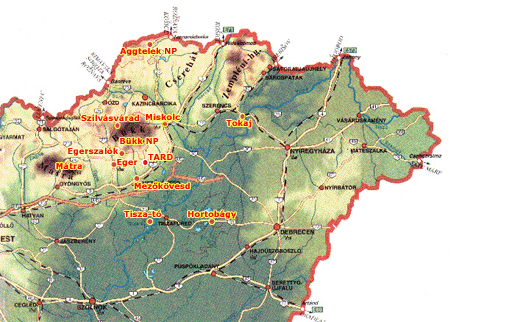

Here some pieces of useful information about you must see by all visitors:
 Mezőkövesd: You can get to the so-called Hadas across the Main Square. Here you can still find some small thached houses with whitewashed walla preserving the features of former times and the structure of the settlement. Here you can observe embroidery-making, puppet-making, furniture- and egg painters, potters, glass grinding, honey-cake or folk-art toys making craftsmen working. Kiss Jankó Bori Memorial House, the Folk-Art House and Agricultural Machinery Museum can also be found here. You might as well participate in a real, cheerful matyó wedding with the unforgettable Matyó Dance Band. The closed community of Mezokövesd and its area produced the special Matyó folk art, with a unique architectural style (houses with protruding roofs resembling the Palóc style). Embroidery became known in the middle of the 18th century, providing a new colour in Hungarian folk art with richly embroidered shirts, aprons, and sheets as well as Matyó garments of uniquely imaginative decoration. On of the most popular thermal bath are placed in Zsóry, very close to the Mezőkövesd.
Mezőkövesd: You can get to the so-called Hadas across the Main Square. Here you can still find some small thached houses with whitewashed walla preserving the features of former times and the structure of the settlement. Here you can observe embroidery-making, puppet-making, furniture- and egg painters, potters, glass grinding, honey-cake or folk-art toys making craftsmen working. Kiss Jankó Bori Memorial House, the Folk-Art House and Agricultural Machinery Museum can also be found here. You might as well participate in a real, cheerful matyó wedding with the unforgettable Matyó Dance Band. The closed community of Mezokövesd and its area produced the special Matyó folk art, with a unique architectural style (houses with protruding roofs resembling the Palóc style). Embroidery became known in the middle of the 18th century, providing a new colour in Hungarian folk art with richly embroidered shirts, aprons, and sheets as well as Matyó garments of uniquely imaginative decoration. On of the most popular thermal bath are placed in Zsóry, very close to the Mezőkövesd.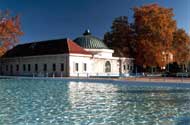 Eger:
Eger is one of the nicest baroque cities of Hungary. It has been a bishop seat for a thousand years and the city is full of the remainings of historical events. The second largest church of Hungary can be found in Eger, with the largest organ. The castle from the Middle Ages has yielded the remainings of churches to the archeologists, and the 15th century gothic bishop palace has been restructured. This is also where the Castle Museum is located, portraying the common history of the castle and the city. The minaret reaches some 40 meters above the city, being the most northern Turkish building from the Ottoman ages.
Eger:
Eger is one of the nicest baroque cities of Hungary. It has been a bishop seat for a thousand years and the city is full of the remainings of historical events. The second largest church of Hungary can be found in Eger, with the largest organ. The castle from the Middle Ages has yielded the remainings of churches to the archeologists, and the 15th century gothic bishop palace has been restructured. This is also where the Castle Museum is located, portraying the common history of the castle and the city. The minaret reaches some 40 meters above the city, being the most northern Turkish building from the Ottoman ages.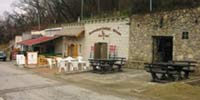 On the basis of its size this basilica is the second among the churches of Hungary. There is a thermal spring in the city, which attracts lot of tourists looking for recreation and thermalbath. In addition to the thermal water and the historical atmosphere, Eger attracts a lot of people with its famous wine. The red and white wine are served in wine cellars of several hundred years of age.. At the end of the last century more findings dating from the time of the Hungarian conquest rose to the surface near the "Szépasszony-völgy" (The Beautiful Woman's Valley): famouse wine cellars with tradition gipsy-music. In the Northern branch of the valley you can see (with prior notice) the oldest, historic cellar of the wine-district, the 'Istenes Pince' ('Godly Cellar'), operating as a secret church under the Turkish occupation of Hungary.
On the basis of its size this basilica is the second among the churches of Hungary. There is a thermal spring in the city, which attracts lot of tourists looking for recreation and thermalbath. In addition to the thermal water and the historical atmosphere, Eger attracts a lot of people with its famous wine. The red and white wine are served in wine cellars of several hundred years of age.. At the end of the last century more findings dating from the time of the Hungarian conquest rose to the surface near the "Szépasszony-völgy" (The Beautiful Woman's Valley): famouse wine cellars with tradition gipsy-music. In the Northern branch of the valley you can see (with prior notice) the oldest, historic cellar of the wine-district, the 'Istenes Pince' ('Godly Cellar'), operating as a secret church under the Turkish occupation of Hungary.Egerszalók: The village is famous for its excellent wines and its medicinal hot spring. The hot spring was found during oil prospecting in 1961. The deposit of salt from it constitutes a natural formation unparalleled in the district, its steaming white cone making an attractive sight amidst the dark pine trees. Analyses of the water have raised the estimation of Egerszalók's hot spring, which is now rated the source in the county with the greatest potentials. Examinations in 1989 for trace elements showed the spring to have international significance for the treatment of both physical handicaps and multiple sclerosis (MS). Egerszalók's water, with a temperature of 68oC, was certified as therapeutic in 1992.
Bükk NP:
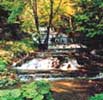 Szilvásvárad: Table-land of the Bükk Montains, Szalajka Valley, Orbán House, Muzeum of Foresrty, Lipicer Stud. These and many many others facilities and attractions can be found in the valley of Szalajka. It is famous for its nice artificial lakes, its trouts and its waterfalls where the water of small Szalajka river flows down on the massive limestone rocks like a veil. For the way trough the valley You can also use a special extensive railway system.
Szilvásvárad: Table-land of the Bükk Montains, Szalajka Valley, Orbán House, Muzeum of Foresrty, Lipicer Stud. These and many many others facilities and attractions can be found in the valley of Szalajka. It is famous for its nice artificial lakes, its trouts and its waterfalls where the water of small Szalajka river flows down on the massive limestone rocks like a veil. For the way trough the valley You can also use a special extensive railway system.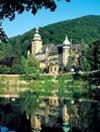 Aggtelek: The name of Aggtelek was made famous, both in Hungary and abroad, by one of the most extensive cave systems in Europe. Most of the Aggtelek cave system is located within Hungary, but its western branch extends to Slovakia, continuing in the cave systems of Domica and the karstland. (The border station 1 km away from the entrance to Baradla Cave makes it possible to go and have a look at the Slovakian Domica Cave as well.)The karst hills were formed about 500 million years ago.
Aggtelek: The name of Aggtelek was made famous, both in Hungary and abroad, by one of the most extensive cave systems in Europe. Most of the Aggtelek cave system is located within Hungary, but its western branch extends to Slovakia, continuing in the cave systems of Domica and the karstland. (The border station 1 km away from the entrance to Baradla Cave makes it possible to go and have a look at the Slovakian Domica Cave as well.)The karst hills were formed about 500 million years ago.Lillafüred: A climatic resort built at the junction point of the Garadna and Szinva Valleys, at the bank of Hámor Lake. Hámor Lake is the result of an initiative by the Fazola family. The water demand of modern plants was only managed to be met by building a dam. A natural sight of the park around Palota Hotel is the waterfall to be approached through the hanging garden of the hotel: its rumble can be heard far away as well. The artificial entrance to Anna Cave or Spring Travertine Cave is to be found near the waterfall, in the wall of the hanging garden.
Miskolc:
From the hill of Miskolc, the Avas, a beautiful view opens up to the surrounding area: to the North are the 7,000 ft. peaks of the Tatras, and to the South the infinite space of the Great Hungarian Plain. The Bukk mountains climb over the horizon to the West, and the massive Tokaj hill can be seen to the East.The development of Miskolc as a major town relied on the industrial developments of the second half of the 19th century, with the rapid expansion of the iron and coal industries. Miskolc enjoys a colorful cultural life with a National Theater (the nation's first), libraries, galleries, various schools, and the University of Miskolc.
 Fortress of Diósgyőr: At the end of 1364 Lajos I. (the Great) annexed the town of Miskolc to the Diósgyőr Royal Estate. The 13th century Diósgyőr Royal Castle, which was accomplished and magnificently developed in the 15th century, became the centre of the Royal Estate including Miskolc. The exploration and restoration of the castle began in 1953. Owing to the constant restoration the Diósgyőr Castle is one of the most important medieval monuments of the country. During the exploration several findings, objects and wings of building connected to the history of the castle were found. The Diósgyőr Castle is not only a beauty spot but it also holds international and national open-air performances.
Fortress of Diósgyőr: At the end of 1364 Lajos I. (the Great) annexed the town of Miskolc to the Diósgyőr Royal Estate. The 13th century Diósgyőr Royal Castle, which was accomplished and magnificently developed in the 15th century, became the centre of the Royal Estate including Miskolc. The exploration and restoration of the castle began in 1953. Owing to the constant restoration the Diósgyőr Castle is one of the most important medieval monuments of the country. During the exploration several findings, objects and wings of building connected to the history of the castle were found. The Diósgyőr Castle is not only a beauty spot but it also holds international and national open-air performances. Avas Cellars - Lookout Tower The Avas has been the storage and hiding place of the town for centuries. More than 800 cellars were scooped into the dry and damp-proof andesite tuff of the Avas. The hollows run parallel to the inner side of the building 6-7 metres distant from each other. Most of them are 10-20 metres long but there are some 50-100 metres long hollows as well.
Avas Cellars - Lookout Tower The Avas has been the storage and hiding place of the town for centuries. More than 800 cellars were scooped into the dry and damp-proof andesite tuff of the Avas. The hollows run parallel to the inner side of the building 6-7 metres distant from each other. Most of them are 10-20 metres long but there are some 50-100 metres long hollows as well. 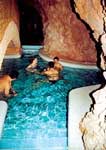 The temperature of the hollows varies between 6-10 depending on their depth. It is the same in winter and summer. Most of the cellars are at least 300 years old and hardly any of them are younger than 200 years. There has always been some kind of a lookout tower on the top of the Avas Hill showing a beautiful view to the visitors. The last tower made of wood was burnt down. The present one was built on the 203 metre-high platform between 1962 and 1963. The lookout tower is 71 metres tall and was planned by Hofer Miklós.
The temperature of the hollows varies between 6-10 depending on their depth. It is the same in winter and summer. Most of the cellars are at least 300 years old and hardly any of them are younger than 200 years. There has always been some kind of a lookout tower on the top of the Avas Hill showing a beautiful view to the visitors. The last tower made of wood was burnt down. The present one was built on the 203 metre-high platform between 1962 and 1963. The lookout tower is 71 metres tall and was planned by Hofer Miklós.Miskolctapolca: 7 km from the centre of Miskolc, the 10-acre spa resort is situated in a quiet valley among forests. It is famous for its springs and spas. There are hot springs at the rim of Bükk Hills formed of limestone; cold springs, on the other hand, originate from rising karst water. Medicinal waters are excellent for heart and vascular diseases of nervous origin, stomach problems of the same kind, as well as any damage in the sympathetic nervous system.
 Mátra Mountains: The nearly 50 km long hills can be divided into five regions: Western Mátra, Central Mátra with the peaks of Kékes (1015 m) and Galyateto (965 m), Eastern Mátra, Mátralába and Mátraalja. The most important villages include Mátrafüred (The most beautiful popular look-outs of Mátra were established here. As a holiday resort in highlands, it is situated in the centre of a beauty spot, which is ensnared by carefully signed pathes), Mátraháza, Kékes, Galyateto, Parádfürdő ( Fancy Stable, Museum of Carriages), Parádsasvár (Glassworks, Crystal Manufactury) and Parád. A dense network of tour routes connects all major villages with nice lookout points and beautiful areas worth hiking for.
Mátra Mountains: The nearly 50 km long hills can be divided into five regions: Western Mátra, Central Mátra with the peaks of Kékes (1015 m) and Galyateto (965 m), Eastern Mátra, Mátralába and Mátraalja. The most important villages include Mátrafüred (The most beautiful popular look-outs of Mátra were established here. As a holiday resort in highlands, it is situated in the centre of a beauty spot, which is ensnared by carefully signed pathes), Mátraháza, Kékes, Galyateto, Parádfürdő ( Fancy Stable, Museum of Carriages), Parádsasvár (Glassworks, Crystal Manufactury) and Parád. A dense network of tour routes connects all major villages with nice lookout points and beautiful areas worth hiking for. 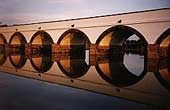 Hortobágy NP: Whenever Hungary is mentioned somewhere throughout the world, it is sure that the Puszta and the Hortobágy is also referred to. Hortobagy's name was made famous by descriptions of scientists, travellers, artists and tourists, however it is more and more often mentioned as the first national park of Hungary. Its valuable landscape, rich fauna and flora, special ethnographic and cultural historic relics together make this region an irreplaceable wealth and a national treasure. Museum of Shepherding, Meggyes Tavern, Nine-hole Bridge, Animal Park on the Puszta (Hungarina Plain), Hortobágyi Taverns.
Hortobágy NP: Whenever Hungary is mentioned somewhere throughout the world, it is sure that the Puszta and the Hortobágy is also referred to. Hortobagy's name was made famous by descriptions of scientists, travellers, artists and tourists, however it is more and more often mentioned as the first national park of Hungary. Its valuable landscape, rich fauna and flora, special ethnographic and cultural historic relics together make this region an irreplaceable wealth and a national treasure. Museum of Shepherding, Meggyes Tavern, Nine-hole Bridge, Animal Park on the Puszta (Hungarina Plain), Hortobágyi Taverns.Tisza-tó: The 127 km area pond is the biggest artificial atanding water of Hungary and the paradise of the lovers of the aquatic sports.
 Tokaj: The world-famous settlement of the Hegyalja wine district was established at the foot of Kopasz Hill, at the junction point of the Rivers Tisza and Bodrog, the Zemplén Hills and the Great Plain. It is an increasingly frequented destination for both Hungarian and foreign tourists, who are attracted by pleasant houses, public buildings, restaurants, and wine cellars. The fame of Tokaj, however, was established worldwide for its wine rather than the nice surroundings and the special atmosphere of the town. This is the place where the world-famous wine made from raisins originates from, having gained respect and rank for this town.
Tokaj: The world-famous settlement of the Hegyalja wine district was established at the foot of Kopasz Hill, at the junction point of the Rivers Tisza and Bodrog, the Zemplén Hills and the Great Plain. It is an increasingly frequented destination for both Hungarian and foreign tourists, who are attracted by pleasant houses, public buildings, restaurants, and wine cellars. The fame of Tokaj, however, was established worldwide for its wine rather than the nice surroundings and the special atmosphere of the town. This is the place where the world-famous wine made from raisins originates from, having gained respect and rank for this town. Tard: It belongs to the Matyó villages (read more about Matyó in Mezőkövesd details) where the real values of folkart culture are still preserved. It is rich in folk-art traditions folk-art costumes and songs. Mezőkövesd, the nearest town is just 10 km far from here, the famous spa in Bogács is just 3 km far, there are wine cellars.
Tard: It belongs to the Matyó villages (read more about Matyó in Mezőkövesd details) where the real values of folkart culture are still preserved. It is rich in folk-art traditions folk-art costumes and songs. Mezőkövesd, the nearest town is just 10 km far from here, the famous spa in Bogács is just 3 km far, there are wine cellars.Thermal Bath: Eger, Egerszalók, Bogács, Mezőkövesd, Tiszafüred, Debrecen, Hajdúszoboszló, Miskolctapolca (Cave Bath) a many many others :-)
 Bogács: Bogács is a village with 2000 inhabitants. It lies below the Bükk, in the valley of the Hór and Szoros rivers. It was settled in the primeval ages. Archeologists have found a site from the Bronze Age - a rich collection of archeological findings. Thanks to the natural conditions the village is known as a spa village. After some depth-drilling in the fifties and sixties, thermal water was found in the villade. The pool area has 6 pools, thereof 4 are filled with thermal water, 1 pool is for the children and 1 for the swimmers. That means the pools are suitable for the demanding customers anf for all age categories. The water contains sulphur, carbonic acid and its temperature about 70°C. It has healing effects, healing not only rheumatic pains. Its healing powers can help to those with digestive problems. Because of its caustic effects, it can also be used for the treatment of teeth and mouth.
Bogács: Bogács is a village with 2000 inhabitants. It lies below the Bükk, in the valley of the Hór and Szoros rivers. It was settled in the primeval ages. Archeologists have found a site from the Bronze Age - a rich collection of archeological findings. Thanks to the natural conditions the village is known as a spa village. After some depth-drilling in the fifties and sixties, thermal water was found in the villade. The pool area has 6 pools, thereof 4 are filled with thermal water, 1 pool is for the children and 1 for the swimmers. That means the pools are suitable for the demanding customers anf for all age categories. The water contains sulphur, carbonic acid and its temperature about 70°C. It has healing effects, healing not only rheumatic pains. Its healing powers can help to those with digestive problems. Because of its caustic effects, it can also be used for the treatment of teeth and mouth.